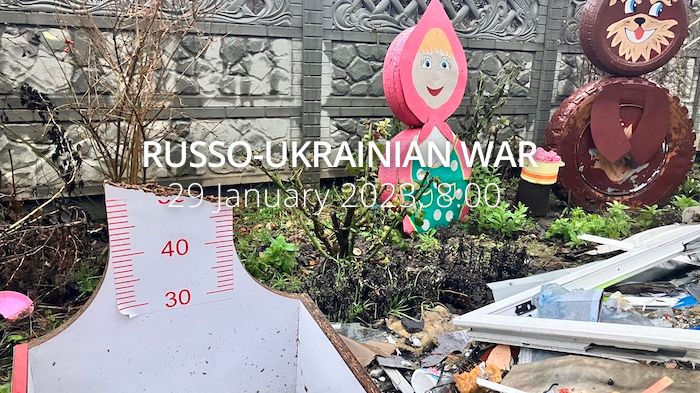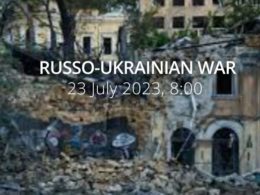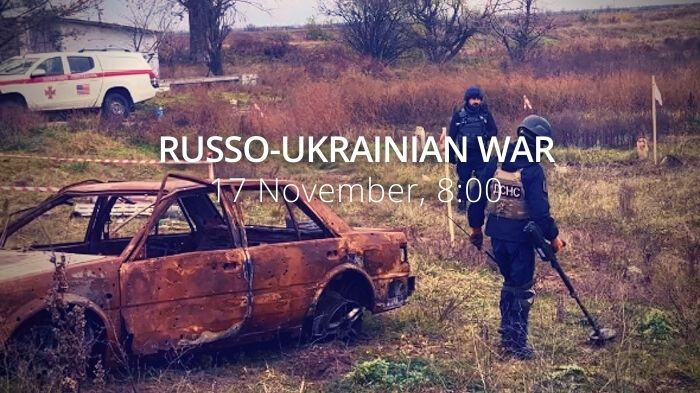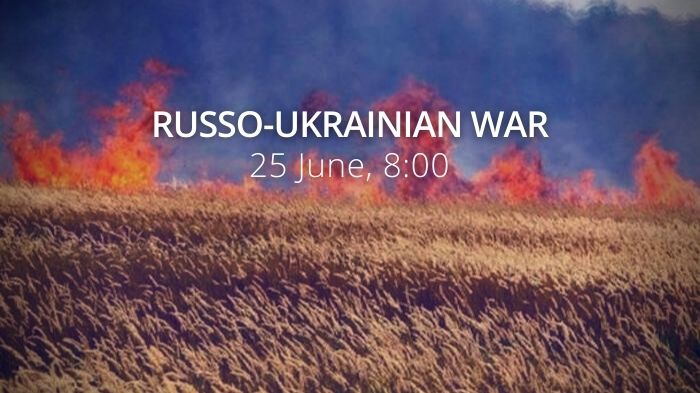UN refugee chief: Russia violating principles of child protection in Ukraine. Fierce fighting for Vuhledar and Bakhmut continues. A significant deficit remains in the power system of Ukraine; the most difficult situation in Odesa Oblast.
Daily overview — Summary report, January 29, 2023
A map of the approximate situation on the ground in Ukraine as of 00:00 UTC 28/01/23. pic.twitter.com/SouXdvoVqs
— War Mapper (@War_Mapper) January 28, 2023
The General Staff’s operational update regarding the Russian invasion as of 18.00 pm, January 29, 2023 is in the dropdown menu below:
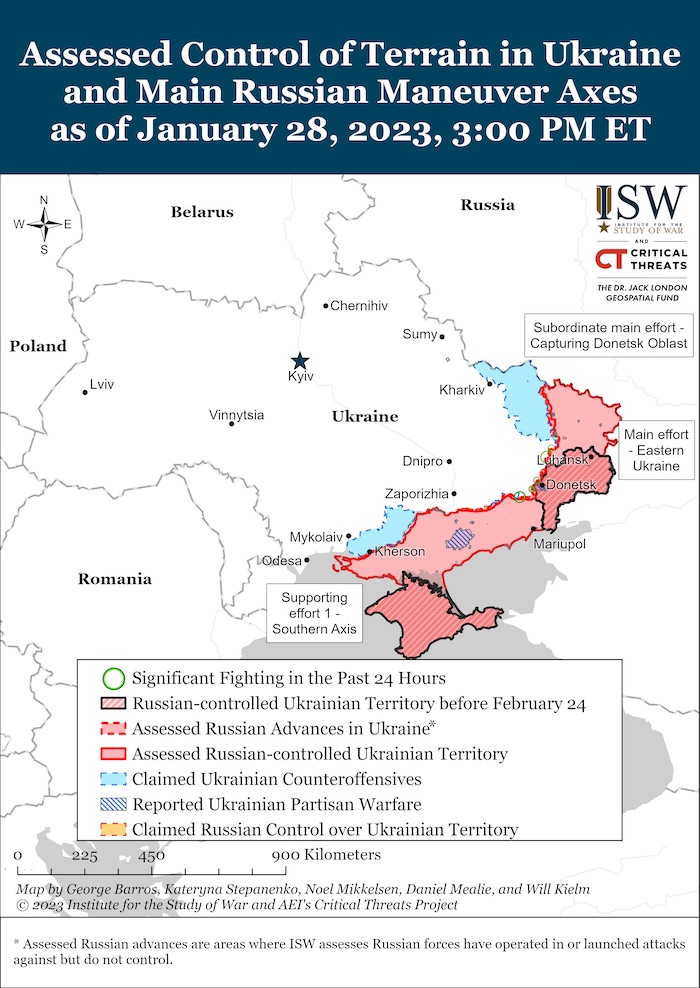
“Russian forces do not cease their attempts to destroy the critical infrastructure of Ukraine and continue to attack civilian objects and residential areas.
Over the past 24 hours, Russian occupiers launched 1 missile and 32 air strikes and conducted more than 65 MLRS attacks, including on the civilian infrastructure of Donetsk and Kherson oblasts. The attacks caused casualties among the civilian population.
The threat of air and missile strikes remains high across Ukraine.
Russian forces continue offensive operations on Bakhmut, Avdiivka and Novopavlivka axis. Kupiansk, Lyman, Zaporizhzhia and Kherson axis – Russian forces stay on the defensive.
Ukrainian Defense Forces repelled attacks in the vicinities of Dibrova and Bilohorivka (Luhansk oblast); Yampolivka, Verkhn’okam’yans’ke, Rozdolivka, Sil’, Blahodatne, Paraskoviivka, Bakhmut, Ivanovs’ke, Klishchiivka, Novomykhailivka, Vodyane, Mariinka, Pobieda, and Vuhledar (Donetsk oblast).
Volyn, Polissya, Sivershchyna and Slobozhanshchyna axes: no changes, no offensive groups of Russian forces identified. [Certain units of Russian 6th Motorized Rifle Division, 3rd Army Corps undergo training in Belarus.]
- Sivershchyna axis: the vicinities of Mykolaivka (Chernihiv oblast); Novovasylivka, Seredyna Buda, Muraveinya, Bachivsk, Budivelne, Volkivka, Volfine, and Yunakivka (Sumy oblast) came under enemy mortar fire.
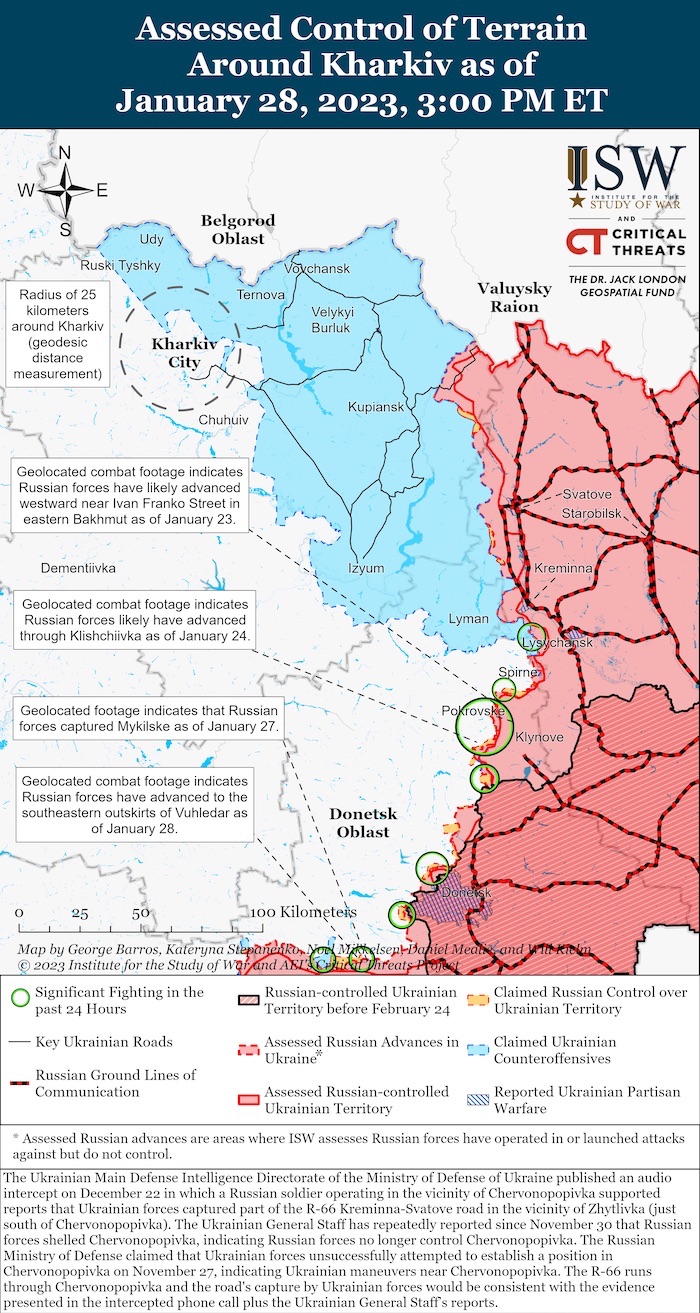
- Slobozhanshchyna axis: the vicinities of Huryiv Kozachok, Krasne, Starytsya, Okhrimivka, Hlyboke, Kozacha Lopan, Dvorichanske, Varvarivka, Novomlynsk, Dvorichna, Zapadne, Neskuchne, Ternova, Strilecha, and Kup’yans’k (Kharkiv oblast) were subjected to Russian mortar and artillery attacks.
- Kupiansk axis: Russian forces shelled positions of Ukrainian troops in the vicinities of Ivanivka, Kislivka, and Krokhmalne settlements (Kharkiv oblast); Novoselivske (Luhansk oblast); and Berestov (Donetsk oblast).
- Lyman axis: Makiivka, Chervonpopivka and Dibrova (Luhansk oblast) came under enemy fire.
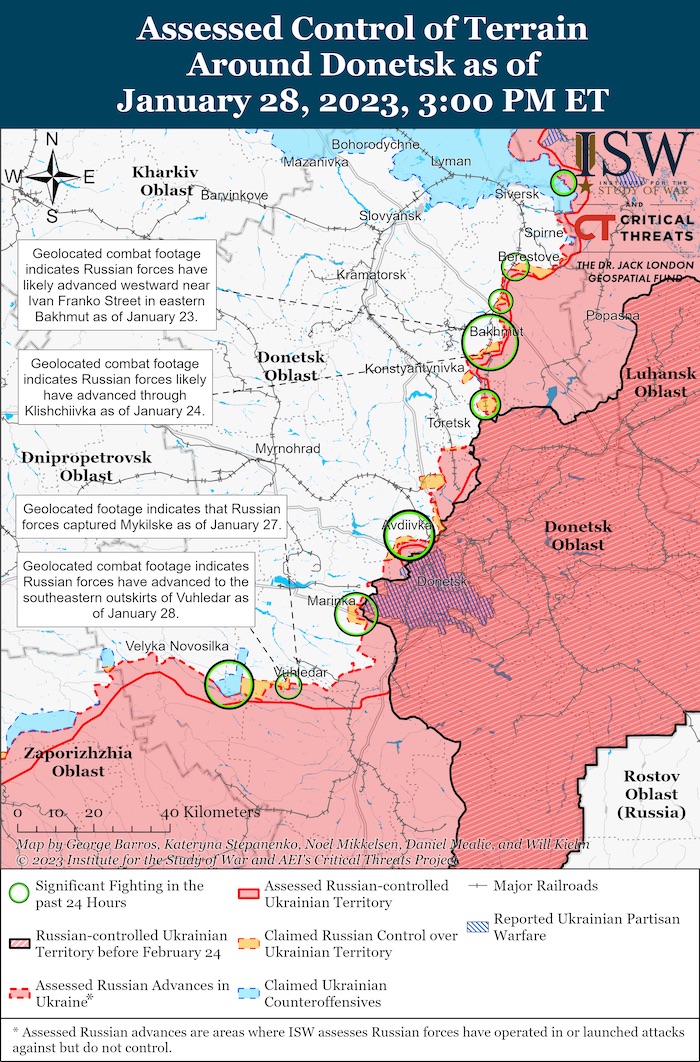
- Bakhmut axis: the vicinities of 21 settlements, including Spirne, Bila Hora, Verkhnokamyanske, Rozdolivka, Bakhmut, New York, Klishchiivka, Kurdyumivka, and Mayorsk (Donetsk oblast) suffered enemy attacks.
- Avdiivka axis: Berdychi, Avdiivka, Vodyane, Nevelske, Vesele, Krasnohorivka, Mariinka, Pervomaiske, and Novomykhailivka came under enemy fire.
- Novopavlivka axis: Bohoyavlenka, Vuhledar, and Zolota Nyva (Donetsk oblast) suffered Russian attacks.
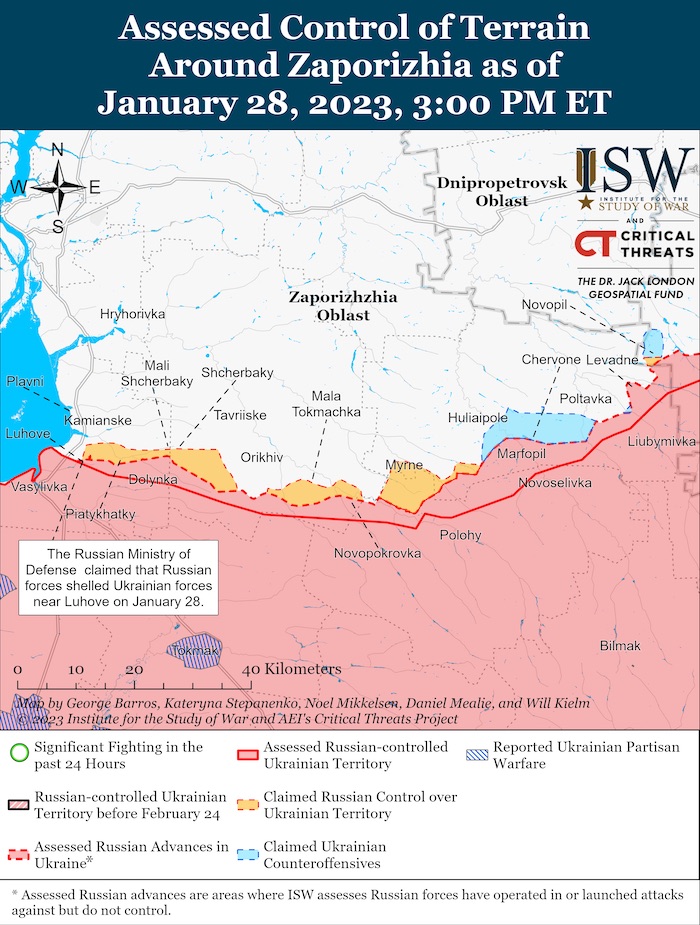
- Zaporizhzhia axis: 19 settlements, including Vremivka, and Novopil’ (Donetsk oblast); Malynivka, Chervone, Hulyaipole, Charivne, Stepove, Orikhiv, and Novodanylivka (Zaporizhzhia oblast) were shelled by the Russian invaders.
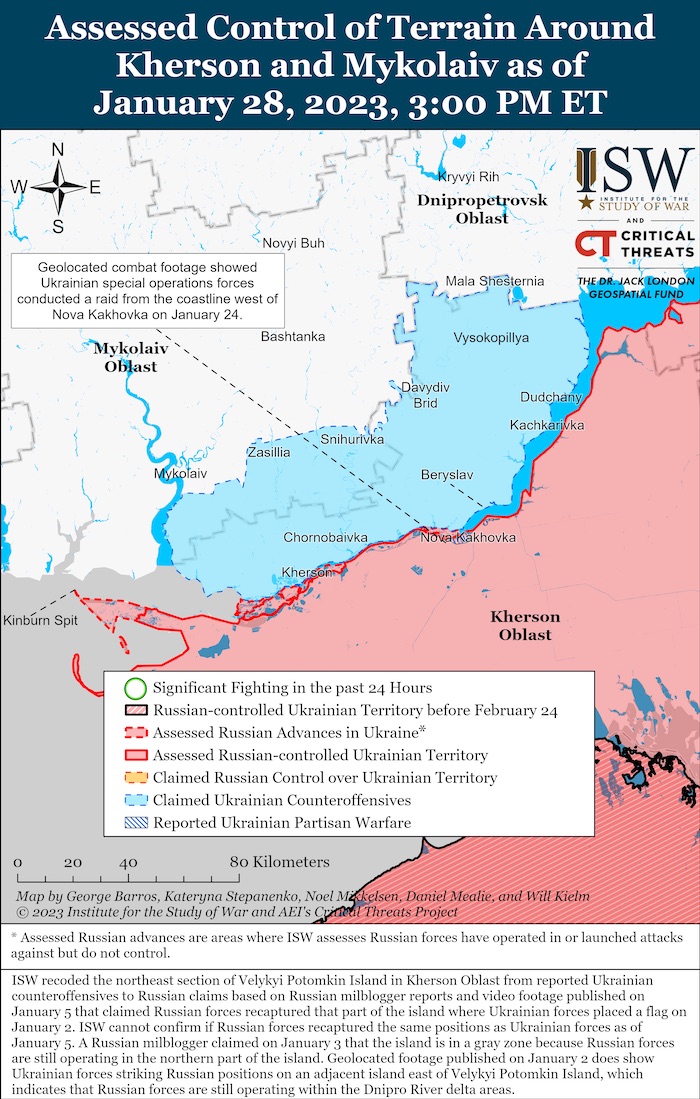
- Kherson axis: the vicinities of Mykhailivka, Havrylivka, Dudchany, Kachkarivka, Chervyn Mayak, Odradokamyanka, Ponyativka, Respublikaniets, Kozatske, Tyahinka, Komysany, and Kherson came under MLRS, artillery and mortar fire.
Russian forces continue to suffer significant losses. Thus, up to 300 mercenaries of the so-called "Wagner Group" private military company were delivered for treatment to the 15th Yuvileyny city hospital (Luhansk oblast). Because most of them are carriers of such diseases as HIV/AIDS, syphilis, tuberculosis and pneumonia, local medics refuse to provide mercenaries with medical care.
[The occupiers continue to exert moral, psychological, and physical pressure on the local residents. For example, employees of Zaporizhzhia NPP who did not sign an employment contract with the occupiers were denied access to the plant, and the workers who were forced to sign the contract were announced salary cuts, arguing that the plant has not been operational.]
[The adversary continues to suffer losses. In particular, the city hospital in Tokmak (Zaporizhzhia oblast) alone has received up to 50 wounded occupiers in recent days. Most of them are sent back to the front line after having been rendered formal aid.]
During the past day, Ukrainian Air Force conducted 4 airstrikes on the concentrations of Russian troops. Meanwhile, Ukrainian missile and artillery units hit 2 command posts, 2 enemy air defence positions, 6x concentrations of troops, 1 ammunition depot, and 1 radio-electronic warfare station.”
Military Updates
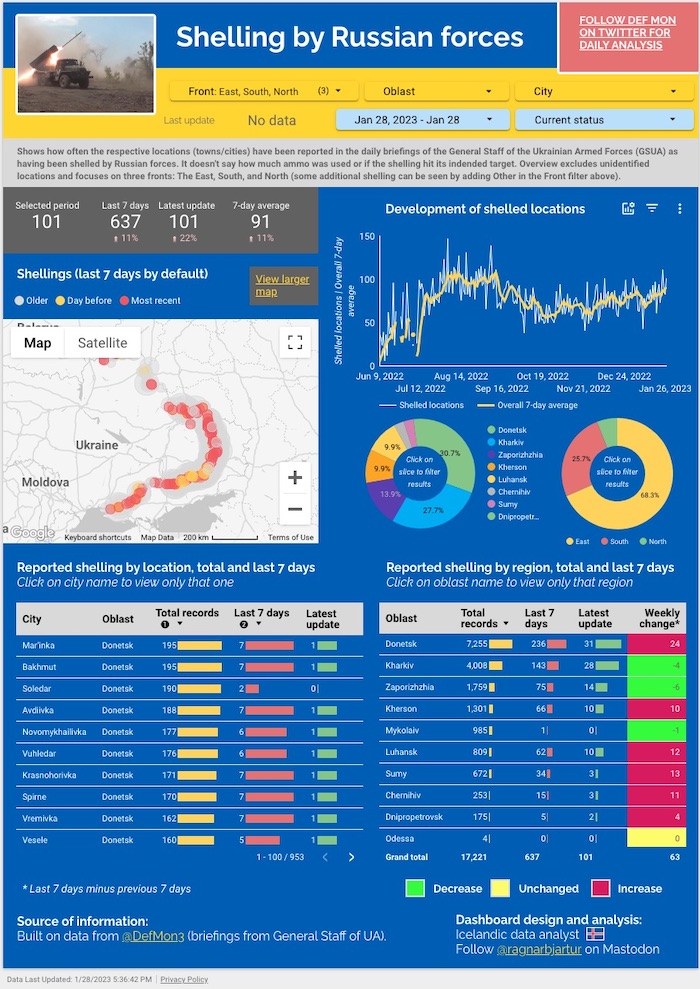
Russia keeps three missile carriers in the Black Sea, Ukrinform reports. "Security situation: there are 16 enemy ships in the Black Sea. There are three missile carriers with 20 Kalibr missiles. The threat of missile attacks is high," Serhiy Bratchuk, Spokesman for the Odesa Regional Military Administration, posted on Telegram.”
Ukraine's General Staff states that Russian occupying forces continue their offensive on the Bakhmut, Avdiivka, and Novopavlivka fronts in Donetsk Oblast despite suffering heavy losses. https://t.co/HtUWYCByLr
— Euromaidan Press (@EuromaidanPress) January 28, 2023
According to British Defence Intelligence, (last 48 hours):
- In recent weeks, the Russian Ministry of Education has provided more detail on the rollout of the previously announced plan to include basic military training in Russia’s secondary school curriculum.
- The module within the ‘Basics of Life Safety’ course will include training with AK series assault rifles and hand grenades, military drill and salutes, and the use of personal protective equipment. The lessons will become mandatory from 01 September 2023. In addition, in December 2022, the Ministry of Science and Higher Education announced a ‘military training basics’ programme for university students.
- The initiatives highlight the increasingly militarised atmosphere in wartime Russia, as well as being a (likely deliberate) evocation of the Soviet Union: similar training was mandatory in schools up to 1993.
- Russia highly likely suffered more than 300 casualties in a strike on troop accommodation at Makiivka near Donetsk City on 01 January 2023. We assess that the majority were likely killed or missing, rather than wounded.
- Following the strike, the Russian Ministry of Defence took the rare step of publicly acknowledging it had suffered casualties, claiming 89 killed. Russian officials likely assessed that it was not viable to avoid comment in the face of widespread criticism of Russian commanders over the incident.
The difference between the number of casualties Russia acknowledged and the likely true total highlights the pervasive presence of disinformation in Russian public announcements. This typically comes about through a combination of deliberate lying authorised by senior leaders, and the communication of inaccurate reports by more junior officials, keen to downplay their failings in Russia’s ‘blame and sack’ culture.
Losses of the Russian army
As of Sunday 29 January, the approximate losses of weapons and military equipment of the Russian Armed Forces from the beginning of the invasion to the present day:
- Personnel – about 126160 (+650),
- Tanks – 3197 (+8),
- Armoured combat vehicles – 6366 (+22),
- Artillery systems – 2195 (+7),
- Multiple rocket launchers –MLRS - 453 (+0),
- Air defence means – 221 (+0),
- Aircraft - 293 (+0),
- Helicopters - 284 (+0),
- Automotive technology and fuel tanks – 5037 (+10),
- Vessels/boats - 18 (+0),
- UAV operational and tactical level – 1947 (+0),
- Special equipment – 199 (+0),
- Mobile SRBM system – 4 (+0),
- Cruise missiles – 796 (+0)
Humanitarian
https://twitter.com/EuromaidanPress/status/1619270746823614465
A significant deficit remains in the power system of Ukraine; the most difficult situation in Odesa Oblast, Ukrainska Pravda reports, citing Ukrenergo national energy company. “Five high-voltage substations were damaged in the latest massive Russian attack on Ukraine's energy infrastructure on 26 January. The consumption rate in the power grid has slightly decreased as of the morning of 28 January; however, the electricity shortage remains significant […].
All regional power distribution companies have been notified of consumption limits that are in force throughout the day. We remind you that each regional power distribution company in its oblast draws up schedules of planned hourly power outages that should ensure the consumption of the oblast at the level of the approved limit, the statement said.
The company notes that the situation in Odesa Oblast is currently the most difficult, and due to significant damage, the planned restoration of Odesa Oblast’s power supply system will take longer than expected.”
Russian forces fired S-300 missile at Kostiantynivka, Ukrinform reports, citing the National Police of Ukraine. “The Russian army on Saturday struck the city of Kostiantynivka in the Donetsk region with an S-300 missile. Two men, 33 and 36, and a 70-year-old displaced woman from Bakhmut were killed in the attack. The number of those wounded is being determined.
As of 15:00, it is already known about three killed and 14 injured civilians, Pavlo Kyrylenko, Head of the Donetsk Regional Military Administration, posted on Facebook.”
Environmental
Crop area decreases by 25% due to war, Ukrainska Pravda reports. “Taras Vysotskyi, First Deputy Minister of Agrarian Policy and Food of Ukraine, has stated that it is currently impossible to use 25% of the crop area due to hostilities or temporary occupation of territories. […] In general, the expected crop area of all categories of farms in the controlled territory of Ukraine for the 2023 harvest should be 21.8 million hectares, which is 6.8 million hectares less than the figure reported in 2021 (28.6 million hectares).
After liberation, it will take a lot of time to clear [these areas off] mines and clean the territories. What the occupier leaves behind needs at least several months, and even up to a year, to return to production, Vysotskyi said.[…] Expensive logistics and the energy crisis remain the key problems for Ukrainian farmers in 2023.
According to preliminary estimates of the Ukrainian Agrarian Business Club, the area under grain crops in 2023 will amount to 8.7 million hectares, which is 22% less than in 2022 and 45% less than in 2021.”
Legal
Over 400 victims of #Russia #warcrimes remain unidentified in liberated #Kharkiv oblast in #Ukraine #StandWithUkraine #RussiaWarCrimes #StopRussia https://t.co/s9D5M1QWIt pic.twitter.com/gWQFqZdYD4
— Halya Coynash (@halyapuff) January 28, 2023
UN refugee chief: Russia violating principles of child protection in Ukraine, Reuters reports. “Russia is violating the "fundamental principles of child protection" in wartime by giving Ukrainian children Russian passports and putting them up for adoption, the UN's refugee agency (UNHCR) chief told Reuters in an interview. […] Giving them (Russian) nationality or having them adopted goes against the fundamental principles of child protection in situations of war, Grandi said. This is something that is happening in Russia and must not happen, he added.
Zelensky, after meeting Grandi on Wednesday, called for mechanisms to be established to defend and return children and adults deported to Russia since its invasion of Ukraine last February, as well as to punish those responsible.
Grandi said his agency was unable to estimate the number of children who had been given passports or put up for adoption, as access in Russia was extremely limited. We are seeking access all the time, and access has been rather rare, sporadic and not unfettered, he said.”
Over 400 bodies found within Kharkiv region’s liberated areas remain unidentified, Ukrinform reports, citing the National Police of Ukraine. “Over 400 victims, whose bodies were found within the Kharkiv region’s areas, liberated from Russian invaders, are remaining unidentified. […]
A total of 199 bodies have been identified since forensic experts started to work within the Kharkiv region’s liberated areas. The bodies were found in mass graves, on streets, in houses and mass burial sites. Among the victims, there are those Ukrainians who were tortured to death or shot dead by the Russian military.”
Support
https://twitter.com/EuromaidanPress/status/1619401658022203393
The West promises Ukraine 321 heavy tanks – Ambassador of Ukraine to France, Ukrainska Pravda reports, citing Ambassador of Ukraine to France Vadym Omelchenko and European Pravda which reports that he said this on the air of French channel BFMTV. "To date, many countries have officially confirmed their consent to the supply of 321 heavy tanks to Ukraine, the diplomat said, without specifying which countries he was talking about. Omelchenko stressed it was important to make sure that Ukrainian troops receive tanks as quickly as possible. […] We need this help as soon as possible. If we wait until August or September, it will be too late, he stressed.
It is publicly known that, among other things, on 25 January, US President Joe Biden confirmed his intentions to transfer 31 M1 Abrams tanks to Ukraine […]. Britain will transfer 14 Challenger 2 tanks, and Germany is to send 14 Leopard 2 A6 tanks. At the same time, France hasn't made a decision yet about the transfer of Leclerc tanks.”
Poland to deliver 60 modernized tanks to Ukraine, The Kyiv Independent reports. “Poland will deliver 60 modernised tanks to Ukraine in the near future, including locally-made PT-91 Twardy models, Ukrainian presidential office head Andrii Yermak wrote on Telegram on Jan. 27. The tanks will be delivered on top of the fourteen German-built Leopard 2 tanks that Warsaw pledged to Ukraine on Jan. 11, the transfer of which was only recently officially approved by Berlin.
In an interview with Canadian television channel CTV news, Polish Prime Minister Mateusz Morawiecki said that 30 of the tanks would be PT-91 Twardy models, with the remainder understood to be upgraded Soviet-built T-72 tank.
The PT-91 Twardy is a main battle tank based on the design of the T-72, the primary tank model operated by both sides in Russia's war against Ukraine. Unlike other upgraded T-72 models, the Twardy was built from scratch in Poland with domestically produced parts between 1995-2002. Improvements over the T-72 design include better reactive armor, an improved autoloader, and a newly designed fire control system.”
Ukraine seeks fighter jets from international allies, Ukrainska Pravda reports, citing Yurii Ihnat, spokesman for the Ukrainian Air Force, in a commentary for El Pais news outlet and Ukrainska Pravda. “Ihnat confirmed that, in addition to the complicated political negotiations required to carry out this operation, Kyiv would not be able to rely on these aircraft on the battlefield in the short term, as it will take at least six months to train pilots and ground support teams.
Ihnat has said in a comment to Ukrainska Pravda that Ukraine is currently not expecting fighter jets from its allies. He has also pointed out that he did not tell the number of fixed-wing aircraft that Ukraine wants to receive, as the Spanish news outlet stated that Ihnat said Kyiv wants to get 24 interceptor jets, and explained that it was a matter of wrong translation. Receiving American-made F-16 jets is Ukraine’s priority. Earlier, Kyiv was considering the French Rafale and Swedish Gripen.
As previously reported, the [the UK] stands for supplying fighter jets to Ukraine after Russian troops are pushed out of Ukrainian territory. Previously, German Defence Minister Boris Pistorius spoke out against providing Ukraine with German fighter jets. "This is out of the question," he said. Meanwhile, Dutch Foreign Minister Wopke Hoekstra said last week that the Netherlands "has no taboo" on discussing a request for F-16s if Ukraine asked for them, and the Slovak government has spoken directly about plans to give Ukraine Soviet-made MiG-29s.”
Pentagon discussing supplying Ukraine with F-16 fighter jets, Ukrinform reports, citing Politico. “A contingent of military officials is quietly pushing the Pentagon to approve sending F-16 fighter jets to Ukraine to help the country defend itself from Russian missile and drone attacks. I don't think we are opposed, said a senior Department of Defense official about the F-16s, speaking on condition of anonymity to discuss a sensitive debate. The person stressed that there has been no final decision.”
France is considering transferring fighter aircraft to Ukraine, The Drive reports. “With the transfer of modern Western-made tanks now secured, Ukraine is turning its sights once again to advanced fighter jets, with France today stating that it had not ruled out providing Kyiv with combat aircraft from its own stocks. A French government official confirmed that unnamed Eastern European countries and Denmark were also possible candidates to provide fighter jets to Ukraine, while a Ukrainian Air Force spokesman says that a transfer of advanced Rafale multirole fighter jets is on the table.
Speaking today, Thomas Gassilloud, chairman of the National Assembly’s National Defense and Armed Forces Committee, said that the French government could agree to supply Ukraine with the fighter jets that it so badly wants. […]
Gassilloud added that the French government had certain conditions regarding a transfer of this kind, chief among them being a judgment that the jets didn’t constitute a risk of escalating the war to a point that it brought Russia into conflict with NATO. France would want to ensure that any donated jets didn’t undermine French or European security, although drawing upon stocks of aircraft that have already been withdrawn would seem to be a simple way around that.”
Ukraine in talks with allies about getting long-range missiles, aide says, Reuters reports. “Expedited talks are under way among Kyiv and its allies about Ukraine's requests for long-range missiles that it says are needed to prevent Russia from destroying Ukrainian cities, a top aide to President Volodymyr Zelenskyy said on Saturday.
Ukraine has won promises of Western battle tanks and is seeking fighter jets to push back against Russian and pro-Moscow forces, which are slowly advancing along part of the front line.
To drastically reduce the Russian army's key weapon - the artillery they use today on the front lines - we need missiles that will destroy their depots, presidential adviser Mykhailo Podoliak told Ukraine's Freedom television network. He said on the Russian-occupied Crimean Peninsula there were more than 100 artillery warehouses.”
France and Italy place large order for missiles for air defence systems, which will soon be delivered to Ukraine, Interfax reports. “A total of 700 Aster-30 anti-aircraft missiles for Mamba SAMP/T anti-aircraft missile systems with a total value of $2 billion will be ordered from the transnational company MBDA, and the air defense systems themselves will soon be delivered to Ukraine. […]
As reported, France and Italy accepted Ukraine's request for the supply of the Mamba SAMP/T air defense system in mid-December 2022. On January 13 of this year, it was reported that the Italian side had already made a decision to transfer the battery of the SAMP/T anti-aircraft missile system to Ukraine.”
Ukraine sets up drone assault units, Reuters reports. “Ukraine said on Friday it was setting up drone assault companies within its armed forces that will be equipped with Starlink satellite communications, as it presses ahead with an idea to build up an "army of drones". Commander-in-chief Valeriy Zaluzhnyi signed off on the creation of the units in a project that will involve several ministries and agencies, the General Staff said. […]
Ukraine's defence minister told Reuters last month that he regarded drones as the future of modern warfare. Unmanned aircraft have played a crucial role on both sides since Russia launched a full-scale invasion of Ukraine in February last year.”
Ukraine's Defence Ministry signs 16 contracts with Ukrainian drone manufacturers, Ukrainska Pravda reports, citing Ministry of Defence of Ukraine. “The ministry announced a joint meeting of representatives of the Ministry of Defence and the General Staff, as well as Ukrainian developers and UAV manufacturers, on Saturday, 28 January. The Ukrainian Defence Ministry will increase the procurement of UAVs for the Armed Forces of Ukraine in 2023. About UAH 20 billion (approx.. US $ 544,055) should be allocated to this segment in 2023 […].
It was noted during the meeting that the Ministry of Defence is deepening cooperation with Ukrainian developers and manufacturers of UAVs. In particular, 16 state contracts with domestic manufacturers of unmanned aerial vehicles have recently been signed."
Rheinmetall eyes boost in munitions output, HIMARS production in Germany, Reuters reports. “German arms-maker Rheinmetall is ready to greatly boost the output of tank and artillery munitions to satisfy strong demand in Ukraine and the West, and may start producing HIMARS multiple rocket launchers in Germany, CEO Armin Papperger told Reuters.
He spoke days before Germany's defence industry bosses are due to meet new defence minister Boris Pistorius for the first time […]. With the meeting, Pistorius aims to kick off talks on how to speed up weapons procurement and boost ammunitions supplies in the long term after almost a year of arms donations to Ukraine has depleted the German military's stocks. […]
We can produce 240,000 rounds of tank ammunition (120mm) per year, which is more than the entire world needs, Papperger said in an interview with Reuters. The capacity for the production of 155mm artillery rounds can be ramped up to 450,000 to 500,000 per year, he added, which would make Rheinmetall the biggest producer for both kinds of ammunition. [ME: Ukraine expend more than twice these numbers a year.] In 2022, Rheinmetall made some 60,000 to 70,000 rounds each of tank and artillery shells, according to Papperger, who said production could be boosted immediately.
Demand for these munitions has soared since Russia's invasion of Ukraine last February, not only due to their massive use on the battlefield but also as Western militaries backfill their own stocks, bracing for what they see as a heightened threat from Moscow.”
New Developments
According to the Ukrainian Embassy in Israel, a Ukrainian woman was killed in the Neve Yaakov neighborhood synagogue terrorist attack in Jerusalem. According to police records, the heinous attack was perpetrated by a Palestinian gunman aged 21. https://t.co/qOdI046gb5
— Euromaidan Press (@EuromaidanPress) January 28, 2023
- Zelensky calls situation on Ukrainian front 'extremely acute', Reuters “Ukrainian President Volodymyr Zelensky on Friday said the situation at the front remained "extremely acute", particularly in the eastern Donetsk region where Russia is stepping up an offensive. Zelensky reported major battles for Vuhledar, to the southwest of Donetsk, and Bakhmut, to the northeast. Bakhmut has largely been pulverised by repeated Russian attacks.”
The situation near #Vuhledar #Bakhmut is "extremely acute," the Russians are not just storming positions, but deliberately destroying these cities, - #Zelenskyy, evening address.
We speak to the press officer of the 68th brigade, 12 km from Vuhledar. #Donbas #Donetsk oblast pic.twitter.com/sODc2ZtrZb
— Euromaidan Press (@EuromaidanPress) January 27, 2023
- After another missile attack, Volodymyr Zelenskyy calls ATACMS vital, Ukrainska Pravda “President Volodymyr Zelenskyy calls on partners to provide Ukraine with long-range missiles to protect it from such attacks as those on Saturday in Kostiantynivka, Donetsk Oblast. Zelensky said that the Russians used S-300 missiles to attack Kostiantynivka in Donetsk Oblaston Saturday morning, killing three people and injuring 14.”
- EU president says Ukraine has unconditional support ahead of summit, Reuters “European Commission President Ursula von der Leyen said ahead of an EU-Ukraine summit next week that Ukraine had unconditional support from the bloc and that the country needed to prevail against Russian attacks to defend European values. […] Ukraine is fighting for our shared values, it is fighting for the respect of international law and for the principles of democracy and that is why Ukraine has to win this war, she said.”
- Russia's deputy foreign minister to meet new US envoy early next week, RIA reports, Reuters “Russia's deputy foreign minister Sergei Ryabkov will hold a meeting with Lynne Tracy, the new US ambassador to Moscow, early next week, the RIA news agency reported on Saturday. Tracy arrived in Moscow earlier this week. Russian Foreign Ministry spokeswoman Maria Zakharova said on Friday that the new US ambassador would not improve ties between the two countries because of what she called Washington's ongoing "hybrid war" against Russia. According to Ryabkov, the traditional presentation of copies of credential by Tracy is already agreed upon.”
- IOC President seeks to allow Russians to attend Olympics despite possible boycott by Ukraine, Ukrainska Pravda reports, citing Ukraine's public broadcasterSuspilne. “Thomas Bach, President of International Olympic Committee (IOC), is willing to "explore the possibility" of allowing athletes from Russia and Belarus to participate in international sports, even though this could lead to a boycott of the competition by Ukraine.”
- Zelensky adviser: IOC promotes 'Russian anti-human policy', Reuters "#IOC proposes to the world promotion of violence, mass murders, destruction. That's why it insists Russian athletes should participate in contests as real 'ambassadors of death', Mykhailo Podoliak wrote on Twitter. Sport doesn't exist outside politics – sport promotes it. Thus, the IOC promotes the Russian anti-human policy. President Volodymyr Zelensky said on Friday that Ukraine would launch an international campaign to prevent Russian athletes from being allowed to compete in the 2024 Games.”
NOC of Ukraine to mull boycotting 2024 Summer Olympics, Ukrinform reports. “The extraordinary General Assembly of the National Olympic Committee of Ukraine will be held on February 3. One of the issues on the agenda is consultations with national sports Federations regarding a possible boycott of the 2024 Olympic Games if Russian and Belarusian athletes are allowed to return to international sports arenas until Russia's aggression against Ukraine ends.”
Assessment
- On the war.
The Institute for the Study of War has made the following assessment as of January 28, 2023:
Russian forces continued offensive operations around Bakhmut on January 28. The Ukrainian General Staff reported that Ukrainian forces repelled Russian assaults near Bakhmut itself, within 18km north of east of Bakhmut near Rozdolivka and Krasna Hora, 6km west of Bakhmut near Ivanivske, and within 20km south of Bakhmut near Klishchiivka and Druzhba. Geolocated footage published on January 26 indicates that Russian forces have likely advanced to the northwestern outskirts of Sil (14km north of Bakhmut). Russian milbloggers claimed that Wagner Group fighters pushed Ukrainian forces back from positions north of Sil and that Russian forces conducted assaults in the direction of Paraskoviivka (9km north of Bakhmut) and Verkhnokamianske (32km northeast of Bakhmut). A Russian milblogger claimed that Russian forces captured a stronghold west of the Bakhmutka River near Paraskoviivka and Krasna Hora (7km north of Bakhmut). Geolocated footage published on January 28 indicates that Russian forces made marginal advances in the northeastern outskirts of Bakhmut. Russian milbloggers claimed that Wagner Group fighters continued assaults in the eastern outskirts of Bakhmut. A Russian milblogger claimed that Russian assault squads pushed Ukrainian forces from positions near Klishchiivka (7km southwest of Bakhmut) back to Ivanivske and advanced to Bila Hora (15km southwest of Bakhmut) from the Siversky Donets-Donbas canal. The Donetsk People’s Republic (DNR) People’s Militia claimed that the 132nd Brigade of the 1st Army Corps continued successful offensive operations in the direction of Toretsk (23km southwest of Bakhmut) and recaptured lost positions from Ukrainian forces.
Russian forces continued offensive operations in the Donetsk City-Avdiivka area on January 28. The Ukrainian General Staff reported that Ukrainian forces repelled Russian assaults near Vodyane (7km southwest of Avdiivka), Marinka (27km southwest of Avdiivka), and Pobieda (32km southwest of Avdiivka). Geolocated footage posted on January 27 indicates that Russian forces have likely advanced near Vodyane. A Russian milblogger claimed that Russian forces advanced near Sieverne (7km west of Avdiivka) and are attempting to advance towards elevated positions near Sieverne and Tonenke (7km west of Avdiivka). The Russian milblogger claimed that these positions would allow Russian forces to advance further towards Orlivka (9km northwest of Avdiivka) and Lastochkyne (6km northwest of Avdiivka) and cut off the Ukrainian ground line of communication (GLOC) between Avdiivka and Orlivka.
Russian forces continued a localized offensive in western Donetsk Oblast on January 28. The Ukrainian General Staff reported that Ukrainian forces repelled Russian assaults near Prechystivka (43km southwest of Donetsk City) and Vuhledar (32km southwest of Donetsk City). Geolocated footage published on January 28 indicates that Russian forces have likely made marginal advances west of Mykilske (27km southwest of Avdiivka) and south of Vuhledar. A Ukrainian military official reported that the situation in the Vuhledar area is stable and that Russian forces conducted failed attempts to outflank Ukrainian forces in the area and take control over the surrounding roads. DNR Head Advisor Yan Gagin claimed that the DNR “Kaskad” Battalion and other Russian formations still hold positions on the eastern and southeastern outskirts of Vuhledar. A Russian milblogger claimed that Russian forces are focusing their main effort on the southeastern outskirts of the settlement and that Ukrainian forces have constructed a serious line of defense in the Vuhledar area. Russian sources amplified footage published on January 28 purporting to show the 40th Naval Infantry Brigade of the Pacific Fleet conducting a ground assault near Vuhledar and supposedly capturing a group of Ukrainian servicemembers.
Conventional Russian forces are likely replacing exhausted Wagner Group forces to maintain the offensive in Bakhmut after the Wagner Group’s offensive in Bakhmut culminated with the capture of Soledar around January 12. The Wagner Group’s assault on Bakhmut has likely culminated with its surge on Soledar. Wagner Group forces in Bakhmut have not made significant gains since capturing Soledar around January 12. Conventional Russian units are now participating in fighting in Bakhmut to reinvigorate the Russian offensive there. Combat footage posted on January 20 indicates Russian Airborne Forces (VDV) are operating around Bakhmut as the footage shows a Russian BMD-4M – niche mechanized equipment exclusively used by the VDV. A Russian source reported that Wagner and VDV elements conducted joint operations in Bakhmut on December 27. The Russian Ministry of Defense has been increasingly reporting that Russian VDV are operating in the Bakhmut area since early January 2023, indicating conventional Russian forces are augmenting if not replacing likely culminated Wagner forces in the area. Wagner Group forces - particularly convicts - have taken heavy causalities in Bakhmut since the fall of 2022. One anonymous US official reportedly stated on January 5 that the Wagner Group’s forces have sustained more than 4,100 deaths and 10,000 wounded, including over 1,000 killed between late November and early December near Bakhmut.
Ukrainian officials have maintained that the Russian offensive on Bakhmut has not culminated. ISW has previously assessed that the Russian offensive on Bakhmut was culminating. We continue to assess that the Wagner offensive has culminated, but now assess that the Russians are committing conventional units to continue the fight. The larger Russian effort against Bakhmut has likely thus not culminated.
Russian forces are attempting to prevent Ukraine from regaining the initiative possibly ahead of a planned decisive Russian offensive in Donbas. Chief of the Russian General Staff Valery Gerasimov stated on December 22 that Russian forces are focusing most of their efforts on seizing Donetsk Oblast, which likely entails Russian forces capturing key positions in western Luhansk Oblast and northeastern Donetsk Oblast to reach the oblasts’ administrative borders. Russian forces have resumed ground attacks in the Vuhledar area (which they unsuccessfully attempted to reach in late October 2022) and are conducting small-scale assaults in Zaporizhzhia Oblast and around Donetsk City. Russian forces are conducting a large-scale offensive operation on the Bakhmut frontline as their current main effort and a defensive operation, for now, on the Svatove-Kreminna line.
The localized attacks on Vuhledar and settlements in Donetsk and Zaporizhzhia oblasts are likely intended to disperse Ukrainian troops and set conditions for a decisive Russian offensive in western Luhansk Oblast, as ISW had previously assessed. Russian forces may be attempting to disperse the Ukrainian grouping of forces on the Svatove-Kreminna line to enable a Russian recapture of Lyman, Donetsk Oblast. Russian forces could seek to use Lyman as a launching point for a decisive offensive to secure Donbas by conducting an offensive from Lyman in tandem with a drive on Bakhmut or from Bakhmut toward Sloviansk if the Russians succeed in capturing Bakhmut. The Russians may imagine that they can drive from their current positions directly to the Donetsk Oblast border along several independent lines of advance, although it is unlikely that they would not recognize the extreme improbability of success in such an attempt. The Russians more likely intend to pursue several phases of offensive operations culminating with securing the borders of Donetsk and Luhansk oblasts. These phases would likely require anywhere from six to 12 months of Russian campaigning, if they are possible at all, extrapolating from past Russian operational patterns and assuming higher levels of Russian combat power and capability than ISW has observed since the start of the war.
Russian forces likely lack the combat power necessary to sustain more than one major offensive operation while fixing Ukrainian forces in western Donetsk and eastern Zaporizhzhia oblasts. There is no open-source evidence to suggest that Russian forces have regenerated sufficient combat power from their losses in the early phases of the war to enable Russian forces to conduct simultaneous large-scale mechanized offensives in the next several months. The Russian military has not demonstrated the capability to conduct simultaneous combined arms offensive operations since early 2022. Russia’s most recent gains around Bakhmut relied on months of human wave attacks to secure territorial gains around Bakhmut by brute force at tremendous human costs. Russia’s earlier capture of Sievierodonetsk and Lysychansk in summer 2022 also did not utilize combined arms but instead relied on large-scale rolling artillery barrages to methodically destroy Ukrainian positions. Russian forces are experiencing growing artillery ammunition shortages that would prevent them from repeating these tactics. It is unlikely, moreover, that the conventional Russian military will be willing to take the kinds of horrific losses the human wave tactic has inflicted on Wagner’s convicts. The Russians’ ability to execute large-scale rapid offensives on multiple axes this winter and spring is thus very questionable.
The conventional Russian military still must undergo significant reconstitution before regaining the ability to conduct effective maneuver warfare. The Russian Ministry of Defense’s (MoD) plans to significantly increase the size of Russia’s military with 12 new maneuver divisions will take at least until 2026, if this effort succeeds at all. Western intelligence and defense officials have not issued any indications that Russia’s effective mechanized warfare combat power has recently increased, and ISW has not observed any indicators along those lines.
The Russian military leadership may once again be planning an offensive operation based on erroneous assumptions about the Russian military’s capabilities, however. Russia's military failures in Kyiv, Kharkiv, and Kherson oblasts have demonstrated time and again that Russian military leadership overestimates the Russian military‘s own capabilities. The degraded Eastern Military District naval infantry elements that are currently attacking Vuhledar will likely culminate even if they succeed in capturing the settlement. The Ukrainian loss of Vuhledar, if it occurs, would not likely portend an immediate Russian breakthrough on multiple lines of advance in Donetsk or in the theater in general, therefore. Ukraine‘s spring rain season (which normally occurs around April) will degrade the terrain’s suitability for maneuver warfare. If Russian forces attempt simultaneous mechanized offensives in the next two months they would likely disrupt Ukrainian efforts to conduct a counteroffensive in the short term, but such a Russian offensive would likely prematurely culminate during the spring rain season (if not before) before achieving operationally significant effects. Russian forces’ culmination would then generate favorable conditions for Ukrainian forces to exploit in their own late spring or summer 2023 counteroffensive. Ukraine would additionally be seeing growing benefits from the incorporation of Western tank deliveries that have only just been pledged.
The Russians are thus very unlikely to achieve operationally decisive successes in their current and likely upcoming offensive operations, although they are likely to make tactically and possibly even operationally significant gains. Ukraine will very likely find itself in a good position from which to conduct successful counter-offensive operations following the culmination of Russian offensives before or during the spring rainy season—always assuming that the Ukrainians do not preempt or disrupt the Russian offensives with a counter-offensive of their own.
The Russian military’s decreasing reliance on Wagner forces around Bakhmut is likely reducing Wagner Group financier Yevgeny Prigozhin’s influence. ISW assessed on January 22 that the Kremlin likely turned to Prigozhin’s irregular forces to get through a rough period following the culmination of Russian conventional forces’ offensive in Luhansk Oblast over the summer of 2022, which misled Prigozhin into overestimating his importance in the Russian military and political spheres. The Kremlin, however, will not need to appease Prigozhin if Russian conventional forces continue to take responsibility for the Bakhmut frontline. ISW has reported that the Kremlin likely has already been slowly terminating his privileges. Gerasimov and the Russian Ministry of Defense (MoD) have also embarked upon new efforts to professionalize the army, an effort that, if successful, would marginalize parallel military formations such as the Wagner Group.
Prigozhin is likely sensing and is overcompensating for his declining influence and has therefore begun to attack the nationalist veteran faction. The veteran faction has been demanding that the Russian military command fix flaws within its conventional campaign instead of focusing on ineffective and unconventional solutions since at least May 2022. Prigozhin continued on January 28 to berate Igor Girkin – a prominent Russian nationalist voice and a former Russian officer who has connections with the Russian veteran community – with vulgar insults and accusations that he is responsible for Russian forces’ loss of Sloviansk in 2014. Prigozhin accused Girkin, Russian State Duma Parliamentarian and Committee on Defense member Lieutenant General (Ret.) Viktor Sobolev, and Leader of the Russian Liberal Democratic Party Leonid Slutsky of living in a past in which Russia relied on conventional forces. Sobolev previously supported the Russian MoD effort to professionalize the military by enforcing grooming standards, and Slutsky avidly advocated for the Kremlin to declare mobilization to rectify the dire situation on the frontlines in early fall 2022. Prigozhin went after these three individuals likely in an effort to undermine their credibility and advocacy for reforms and improvements within the military that further marginalize his undisciplined and brutal parallel military forces.
Prigozhin is also facing bribery accusations, which may further diminish his reputation regardless of their validity. Prigozhin responded to a media inquiry on January 27 regarding speculations that he receives bribes from convicts who do not then serve on the front lines but still receive a pardon for their “service.” The allegations claimed that Prigozhin had recruited and soon released convicted Lipetsk Oblast Parliamentarian Andrey Yaitskiy (who some commentators speculated was physically unfit for military service), which granted him a pardon in exchange for a bribe. Prigozhin attempted to deflect the accusations by claiming that Wagner discharged Yaitskiy with honors following his heavy injuries sustained on the frontlines and included purported testimony from Yaitskiy’s alleged commanders who portrayed him as a hero. ISW cannot independently verify these bribery accusations against Prigozhin, however, their emergence is notable given that corruption and bribery is endemic in Russia and a hated cultural vice among Russians.
Key Takeaways
- Conventional Russian forces are likely replacing exhausted Wagner Group forces to maintain the offensive in Bakhmut after the Wagner Group’s offensive in Bakhmut culminated with the capture of Soledar around January 12.
- Russian forces are attempting to prevent Ukraine from regaining the initiative possibly ahead of a planned decisive Russian offensive in Donbas.
- Russian forces likely lack the combat power necessary to sustain more than one major offensive operation while fixing Ukrainian forces in western Donetsk and eastern Zaporizhzhia oblasts.
- The Russian military leadership may once again be planning an offensive operation based on erroneous assumptions about the Russian military’s capabilities
- The Russian military’s decreasing reliance on Wagner forces around Bakhmut is likely reducing Wagner Group financier Yevgeny Prigozhin’s influence.
- Russian forces reportedly continued limited counterattacks to regain lost positions along the Svatove-Kreminna line.
- Ukrainian forces continued to strike Russian rear areas in Luhansk Oblast.
- Russian forces continued offensive operations in the Bakhmut and Avdiivka-Donetsk City areas. Russian forces continued a localized offensive near Vuhledar in western Donetsk Oblast.
- Russian sources did not report any Russian ground attacks in Zaporizhzhia Oblast for the second consecutive day on January 28.
- Some Russian citizens continue limited efforts to sabotage Russian force generation efforts.
Russian occupation officials continue to set conditions for the long-term forced deportation of Ukrainian children to Russia.
Neither Ukraine nor Russia to achieve absolute victory in this war, Ukrainska Pravda reports, citing RAND report. “RAND Corporation, an American research organisation, published a report titled "Avoiding a Long War" between Russia and Ukraine; they believe that neither of the two countries will achieve an absolute victory. Although successful Ukrainian counteroffensives in Kharkiv and Kherson in fall 2022 renewed optimism about Kyiv’s prospects on the battlefield, Russian President Vladimir Putin’s announcement on September 21 of a partial mobilization and annexation of four Ukrainian provinces was a stark reminder that this war is nowhere near a resolution.
Ukraine had battlefield momentum as of December 2022 and could conceivably fight until it succeeds in pushing the Russian military out of the country. […] Once it is forced out of Ukraine, a chastened Russia would have little choice but to leave its neighbour in peace—and even pay reparations for the damage it caused. However, studies of past conflicts and a close look at the course of this one suggest that this optimistic scenario is improbable.
The research organisation offers possible scenarios of the conclusion of the Russia-Ukraine War: absolute victory, armistice, and political regulation.
Speaking of absolute victory, experts are using a definition according to which "the victor install[s] a new leadership in the defeated state, occupying or annexing the adversary’s territory, or at worst annihilating the adversary’s entire population." This kind of victory was achieved by the allied forces during the Second World War. But in this war, such development is highly unlikely.
Ukraine has never officially declared its intention, experts write, and even if it were to return to its 1991 borders, Russia would still be able to strike with a navy and air force that had not been badly damaged in the war.
Since neither side has the ability to achieve absolute victory, the war will most likely end in some kind of negotiation. Negotiations, unlike absolute victory, require the warring parties to accept some risk that the terms of the peace may be violated. Analysts write that "even a relative ‘loser’ in the war will retain the ability to threaten the other side."
The ceasefire in Ukraine, they expect, will freeze the front line and lead to a long-term cessation of active hostilities. Russia will cease attempts to occupy additional Ukrainian territories and cease missile strikes on Ukrainian cities and infrastructure.
In that case, the Ukrainian Armed Forces would stop their counteroffensives, i.e. strikes against Russian-held areas of Ukraine and against Russia itself. Unresolved territorial issues will remain, which will be disputed politically and economically, not militarily. Analysts conclude that the parties are likely to conduct only minimal trade and borders will be largely closed.
Tanks alone won’t turn the tide of the war in Ukraine, The New York Times reports. “The United States military will, once again, attempt to remake an army in its own image to give Ukraine the best chance to break through entrenched Russian defences. To do that the United States and its allies will not just have to provide the newly promised tanks, armored vehicles and advanced munitions, but also expand what has been something of an ad hoc training program to teach Ukraine’s military to use all the new equipment together. It will be a crash course in what the US military calls combined arms warfare, something that takes months if not years for American units to master. […]
So far Moscow has been deterred from expanding the war and creating newer and stronger Ukrainian units represents the best chance of avoiding a stalemate. As satellite imagery revealed Russians building primary and secondary lines of defensive trenches along the front lines, American government analysts began the year forecasting a deadly stalemate as the likely outcome for 2023. Worried that a frozen conflict favors Russia, the United States and its allies began more earnest discussions in recent weeks about how to change the battlefield dynamics in Ukraine’s favor.
We want to put them in the best possible position so that whether this war ends on the battlefield, whether it ends with the diplomacy or some combination, that they are sitting on a map that is far more advantageous for their long-term future and that Putin feels the strategic failure, Victoria Nuland, a senior State Department official, told the Senate on Thursday. […]
In the next phase of the war, the Ukrainian military will target those dug-in trench lines of Russian units. Breaking through those lines is not just about driving a battalion of tanks over the trenches. It requires a coordinated attack with infantry troops marking targets, tanks firing at those positions and artillery guns providing cover and support. […]
Though tanks have been the focus of attention, military analysts say a critical part of the recent donations by the West may be the 109 Bradley Fighting Vehicles the United States is sending and the large numbers of artillery guns that European allies will send. This equipment is likely to be combined with the German Leopards to help create new Ukrainian armored units. When the full package of Western equipment arrives, Kyiv could create as many as three additional brigades. […]
To ensure Ukraine’s army can conduct such maneuvers will involve an increase in American and European training. For months, the United States avoided sending Ukraine complex new systems that require new training. That attitude has shifted — first when the United States sent American artillery, then longer-range missile systems, and most recently, the Patriot battery system, all of which required training outside Ukraine. […]
Just how realistic it might be for the Pentagon to train the Ukrainians in the complexities of combined arms maneuver warfare in a short time span remains to be seen. Even in peacetime it takes a while for American units to master such operations, and that’s with the luxury of expansive training areas and deep institutional knowledge. […]”
Russia working on psyops against Ukrainian officials, Ukrainska Pravda reports, citing Defence Intelligence of Ukraine (DIU). “The Russian secret services are working on an extensive special information and psychological operation to discredit Ukraine’s military and political leadership.
Defence Intelligence has discovered that the smear campaign will be particularly targeted against Serhii Shaptala, Chief of the General Staff of the Armed Forces of Ukraine; Vasyl Maliuk, chairman of the Security Service of Ukraine; Oleksii Reznikov, Minister of Defence; Andrii Yermak, Head of the President’s Office; and Ivan Vyhovskyi, Acting Chief of the National Police, among others.
Intelligence reports say that among other things, the campaign will include leaking bogus stories in the Ukrainian and international media. The goal of the special information and psychological operation is to sow uncertainty about the defence capabilities of our state among Ukrainian citizens and [our] international partners. This, according to the Russian special services, should lead to political instability inside the country and reduce confidence in Ukraine on the part of the international anti-Putinist coalition."
- Consequences and what to do?
Top NATO official says Alliance ready for direct confrontation with Russia, Ukrainska Pravda reports, citing RTP. “Admiral Rob Bauer, Chair of the NATO Military Committee, has said that the Alliance is ready for a direct confrontation with Russia. […] Rearmament is the Alliance’s top priority. He also acknowledges that the organisation has lost its monopoly on military initiative."
Bauer recalled that during the NATO summit in Madrid last year the Alliance decided to establish four additional multinational battlegroups in Bulgaria, Hungary, Romania and Slovakia in response to Russia’s actions in Ukraine. This is an important signal for Russia… That we are prepared if they decide to go after NATO. This is a red line. If there is a red line, then it is the Russians crossing our borders, the Chair of the NATO Military Committee said.
Bauer said that NATO countries ought to gear civilian industrial production to the needs of the military and expressed his support for the idea of a "war economy in peacetime". He added that he believes that Russia’s strategic objectives go beyond Ukraine, with Moscow wanting to claim the territory of the former Soviet Union.
When asked whether NATO feared escalation in the Russian-Ukrainian war, Bauer said that while the beginning of the Russian aggression constituted an escalation, Ukraine’s desire to reclaim the territories that rightly belong to it is not an escalation. If [the Russians] stop the war today, there will be no escalation, Bauer stressed. On 19 January Rob Bauer said that Russia will remain a threat to NATO even if its forces are defeated in Ukraine.”
Hans Petter Midttun: The German Minister of Defence, Boris Pistorius, plans talks with the German defence industry on how to speed up weapons procurement and boost ammunition supplies in the long term. Western support to Ukraine has not only seen depleted German military's stocks but also emptied stockpiles across NATO. Several countries have accepted strategic risks to help ensure a Ukrainian victory.
While the planned meeting comes across as strategically sound thinking, it is in reality a symptom of a deeper problem.
Please misunderstand me correctly: I full-heartedly support any initiative to ramp up defence industry production. The problem is that the meeting comes nine years too late. It should have been high on the agenda in 2014 after the war started and alongside a decision to urgently strengthen the defence budgets.
Neither was on the agenda nine years ago. As previously reported, only 10 out of 30 countries meet the declared goal of 2% defence expenditure as a share of GDP and 20% equipment expenditure as a share of defence expenditure. That’s an improvement from 2017 – three years into the war – when only five of the 28 members met that goal (the United States, Greece, Britain, Estonia and Poland).
Europe’s unwillingness to meet its defence budget commitment has been a matter of US frustration for years. While former President Trump was the most vocal critic of European defence spending by far, he was only reiterating concerns raised by former US Presidents. Presidents George W. Bush and Barack Obama both pressed NATO allies to increase military spending.
The low defence budgets are not only translated into depleted force structures and stockpiles across the Alliance, but also in European defence industries. The industry is not scaled to meet a full-scale war in Europe and it takes years to reestablish the capacity that was lost after the end of the cold war.
While the German Defence Minister’s intention to meet the German defence industry is crucially important, it underscores a discord within the Alliance.
If the member states had fully grasped the security implications of an increasingly more aggressive Russian foreign policy after it attacked Georgia in 2008 all would have ramped up their defence production 15 years ago. They did not. The Russian attack on Ukraine should have served as a wake-up call. It did not. The full-scale invasion last year should have kicked the NATO member states into action. It did, but it triggered the US more than Europe.
The US administration initiated meetings with the US defence industries in April 2022 already to secure the support of three strategic objectives: Delivering critical capabilities to Ukraine; Enhancing the preparedness of US forces; and Supporting Allies and partners in bolstering their defence capabilities.
Germany – along with many other European countries – is slowly coming to terms with what is at stake.
On 13 January, Norway placed an order for artillery shells worth $263 million to boost its ammunition stocks with national ammunition manufacturer Nammo which enables it to increase its production capacity.
“There is a new geopolitical situation, there is a war in Europe and the preparedness level has been raised,” the Norwegian Defense Minister, Bjoern Arild Gram, told reporters (nearly nine years after the “new geopolitical situation” changed and the war started).
France will boost military spending by more than a third in coming years, President Macron said on 20 January, as he unveiled ambitions to transform the French army to deal with the great "perils" of this century. Finally acknowledging the end of the "peace dividend" of the post-Cold War era, the planned 2024-2030 budget is meant to adapt the military to the possibility of high-intensity conflicts, made all the more urgent after Russia invaded Ukraine almost 11 months ago.
Europe’s lack of strategic appraisal and ability to respond to a deteriorating security situation – the UK and Eastern European countries excluded - will impact Ukraine’s ability to liberate occupied territories in 2023. Ultimately, it might impact our common security and stability.
According to Rheinmetall, it can ramp up the production of both tank and artillery ammunition substantially. Its present production of 60-70,000 rounds of 155mm artillery shells can be immediately ramped up to 450,000 to 500,000 per year, making Rheinmetall the biggest producer of this ammunition. While that sounds impressive, it only represents half of what Ukraine expends a year (while holding back on its expenditure for lack of supplies).
It makes my previous predictions even more relevant. I have long argued that Western military intervention in Ukraine is inevitable. It is bound to happen despite the US and NATO’s continued declarations that they will not deploy military forces to help defend Ukraine.
The West is running out of weapons it can supply Ukraine which it can use with no or limited training. NATO is running out of ammunition and is not prepared for a long-term war. It will, eventually, be forced to bring all of its military capabilities to bear on the battlefield to cut the war short.

